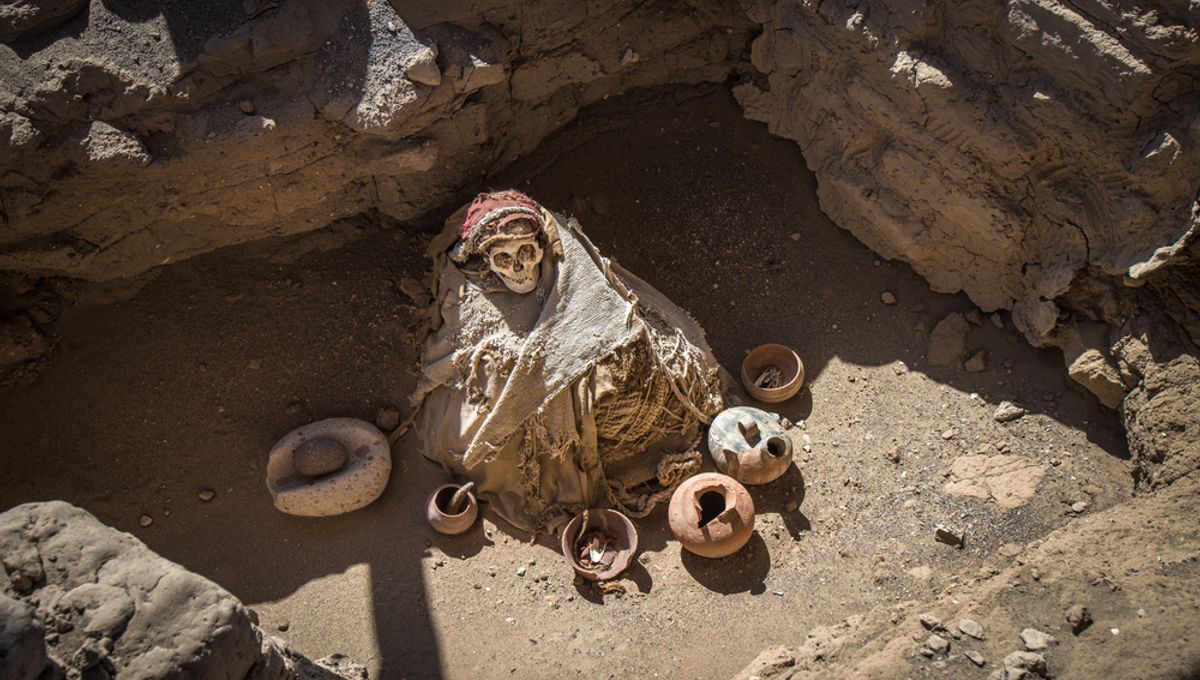
The bones of ancient people laid to rest in the Chincha Valley of southern Peru can often be found covered in an unusual brick-red pigment. The reason behind the colored bones is often debated by modern-day researchers, but a team of archaeologists who recently studied the specimens argues they are a clear reflection of how this mysterious culture kept a tight relationship with the dead – even when they were decomposing and turning into skeletons.
Pigmented human remains and grave goods have been found in over 100 mortuary structures dating from the Late Intermediate Period (1000 – 1400 CE), the Late Horizon (1400 – 1532 CE), and the Colonial Period (1532 – 1825 CE).
In this research, the team looked at 38 pigment samples, including 25 from skulls, and studied them with a number of imaging techniques, including laser ablation, X-ray fluorescence spectrometry, and X-ray powder diffraction
Their analysis showed that the bones had been colored with pigments made from cinnabar (HgS) and hematite (Fe2O3), natural substances which can be ground up to make a dark-red powdery pigment. These powders were kept in containers, perhaps shells, then mixed with water before being applied to the bones with an organic material, most likely fingers or just a leaf.
Interestingly, the cinnabar was not sourced locally and must have been imported. This, the researchers write, suggests that it had a relatively high value and was likely reserved for use on the elites of society, whether they were young or old, male or female.
The process of applying the red pigment appears to be a long and grisly one. Instead of simply burying the dead and forgetting about their physical remains, the decomposing bodies and skeletons were continually revisited by the living in a prolonged process.
Deceased people were placed in a funerary tower structure, known as a chullpa, where they were left to decompose. Once their body had been reduced to a skeleton, they were taken out and covered in pigment. These painted bodies were then returned to the chullpas.
Some painted bones, especially skulls, were eventually take out and placed over the graves of others, seemingly to “protect” the dead from unknown forces. It’s also likely that the bones were revisited as a means to make political claims or used in ceremonies.
“We argue that the painted dead, as person-objects, were engaged with and invoked during mortuary ceremonies held in open spaces in the middle valley, perhaps to make political claims, reproduce social order, or promote renewal and solidarity among select groups,” the study authors write.
“Painted human remains are associated with mortuary sites that have plazas and forecourts, suggesting a connection between the events carried out in these spaces and postmortem treatment of the dead. These events may have involved feasting and dances and mummified remains may have been brought out on litters,” they add.
The researchers looked at written sources and archaeological data that indicate many of the bones from older periods appear to have been revisited during the Colonial era, a violent and destabilizing time when the continent was invaded by Europeans. At this devastating time of famines, war, epidemics, and grave looting, perhaps the practice of revisiting painted bones of long-lost relatives gained renewed significance.
The new study was published in the Journal of Anthropological Archaeology.
Source Link: Red Painted Skulls In Peru Show A Deep Relationship With The Dead